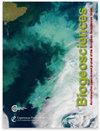对干旱荒漠土壤中CO2通量测量静态室部署的再思考
IF 3.9
2区 地球科学
Q1 ECOLOGY
引用次数: 0
摘要
摘要干旱荒漠土壤中土壤CO2通量(Fs)的机制尚不完全清楚。为了更好地理解这些过程,我们必须准确地估计这些小通量。最常用的方法是静室,它固有地改变了影响通量的条件,并可能引入与通量本身相同数量级的误差。对年土壤呼吸速率的区域和全球评估是基于利用通量室进行的外推点测量。然而,在沙漠生态系统中进行的研究很少讨论在干燥和裸露的土壤中使用静态室的潜在错误。我们假设误差的一个主要来源是土壤表面以上的衣领突出。在2021年的旱季,我们在以色列内盖夫部署了四个不同配置的自动钻铤。Fs表现出夜间摄取和白天排出的重复昼夜循环。在常规凸出的项圈上测量的二氧化碳吸收量明显低于与土壤表面冲洗的项圈。通过热成像,我们证明了突出的领壁扭曲了表层土壤的环境加热和冷却机制,提高了平均表面温度。夜间较高的土壤温度抑制了通量驱动力,即土壤-大气CO2和温度梯度,最终导致实际f的低估高达50%。因此,在常规部署的项圈中,土壤每天的二氧化碳吸收量被低估了35%。这表明,沙漠土壤是一个比以前报道的更大的碳汇,而覆盖地球陆地表面约40%的旱地可能在全球碳平衡中发挥重要作用。本文章由计算机程序翻译,如有差异,请以英文原文为准。
Rethinking the deployment of static chambers for CO2 flux measurement in dry desert soils
Abstract. The mechanisms underlying the soil CO2 flux (Fs) in dry desert soils are not fully understood. To better understand these processes, we must accurately estimate these small fluxes. The most commonly used method, static chambers, inherently alters the conditions that affect the flux and may introduce errors of the same order of magnitude as the flux itself. Regional and global assessments of annual soil respiration rates are based on extrapolating point measurements conducted with flux chambers. Yet, studies conducted in desert ecosystems rarely discuss potential errors associated with using static chambers in dry and bare soils. We hypothesized that a main source of error is the collar protrusion above the soil surface. During the 2021 dry season, we deployed four automated chambers on collars with different configurations in the Negev, Israel. Fs exhibited a repetitive diel cycle of nocturnal uptake and daytime efflux. CO2 uptake measured over the conventionally protruding collars was significantly lower than over the collars flushed with the soil surface. Using thermal imaging, we proved that the protruding collar walls distorted the ambient heating and cooling regime of the topsoil layer, increasing the mean surface temperatures. Higher soil temperatures during the night suppressed the flux driving forces, i.e., soil–atmosphere CO2 and temperature gradients, ultimately leading to an underestimation of up to 50 % of the actual Fs. Accordingly, the total daily CO2 uptake by the soil in the conventionally deployed collars was underestimated by 35 %. This suggests that desert soils are a larger carbon sink than previously reported and that drylands, which cover approximately 40 % of Earth's terrestrial surface, may play a significant role in the global carbon balance.
求助全文
通过发布文献求助,成功后即可免费获取论文全文。
去求助
来源期刊

Biogeosciences
环境科学-地球科学综合
CiteScore
8.60
自引率
8.20%
发文量
258
审稿时长
4.2 months
期刊介绍:
Biogeosciences (BG) is an international scientific journal dedicated to the publication and discussion of research articles, short communications and review papers on all aspects of the interactions between the biological, chemical and physical processes in terrestrial or extraterrestrial life with the geosphere, hydrosphere and atmosphere. The objective of the journal is to cut across the boundaries of established sciences and achieve an interdisciplinary view of these interactions. Experimental, conceptual and modelling approaches are welcome.
 求助内容:
求助内容: 应助结果提醒方式:
应助结果提醒方式:


